Route 7: A small walk around the Great Square
Length of the route: 600 meters
Duration: 25 min
The Great Square is the geographical centre of Kroměříž, but it is mainly the centre of events and the centre of the Kroměříž Urban Conservation Area. The square was in the past known by various names, the oldest attested name from the second half of the 17th century is Markt (marketplace). Gradually it was also called Grosser Markt (Larger marketplace), Hrubý or Velký Rynk. During the 20th century it became the Main Square, Masaryk Square, Grosser Platz (Larger Square), Stalin Square and since 1962 the Great Square. Its origin is related to the foundation of Kroměříž in the second half of the 13th century, when the Great Square with a rectangular ground plan of about one hectare became the foundation and the center of the city. It served as a marketplace (the main market day was appointed to Friday). There were various festivities, parades and celebrations held here. Alongside the entire perimeter of the Great Square there were originally houses with arcades. Some disappeared during the 19th century, these spaces were used for shops and warehouses. There was a lot of business going on here. Directly on the square stood (around the middle of the 16th century) a pillory – the symbol of the city executive. In the 17th century two important Baroque buildings were built here – a fountain and a Marian column. Initially, the square was paved only in some places, subsequently the whole area was then paved with stone paving called “cat’s heads” (obtained from the quarry in Barbořina) in the first half of the 19th century. The square was then repaved several times. In 1948, granite plates and smaller granite cobblestones replaced the original stones. The amount of 235 wagons of these stones was needed for the works.
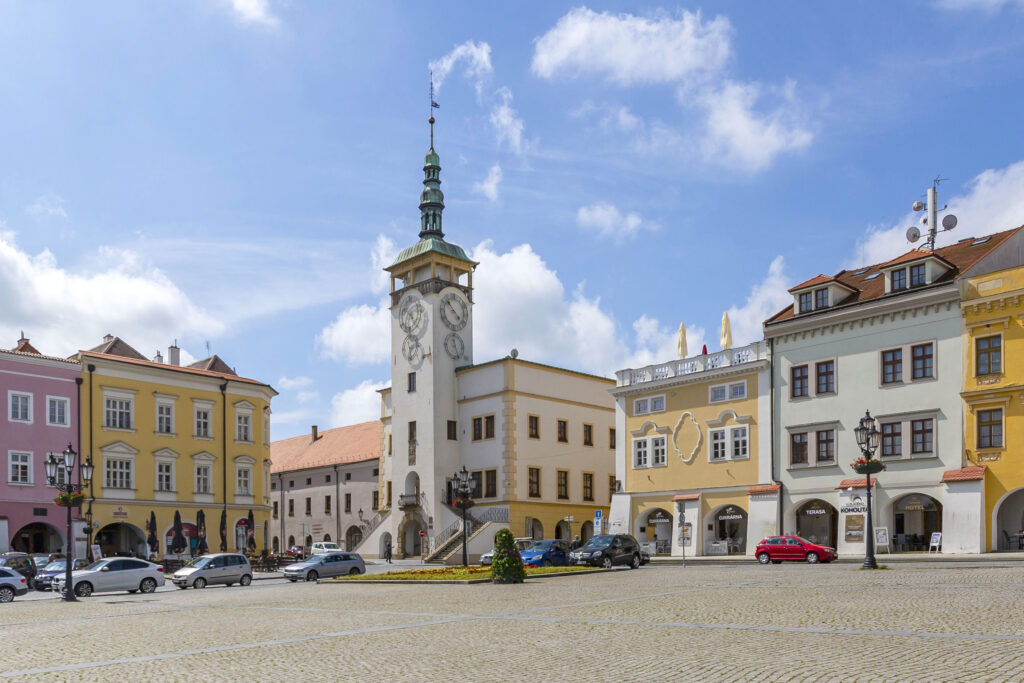
THE MAIN SPOTS OF THE ROUTE:
1 – Town Hall, No. 115
One of the dominant features of the Great Square is the Town Hall. It was built between 1553 and 1561 in the Renaissance style. There was only one floor in the original building. On the first floor the town council led by the burgomaster used to meet, and the town archive was also placed here. On the ground floor there were shops. After the city was captured by the Swedes (1643), the town hall was seriously damaged, it was repaired by the burghers of that time and also by Bishop Karl of Lichtenstein-Castelcorno, as stated by the inscription on the wall in the vestibule of the town hall. In the middle of the 19th century, the town hall was extended by a second floor, where the district court and the regional governor’s office were located. The building and its interior underwent a significant transformation after the World War II.
A distinctive feature of the town hall is a 40-meter-high prismatic tower with an open gallery, it can be entered from an external staircase and at its top there are unique two-face clocks on all four sides (the upper dial shows the hours, the lower minutes), which underwent a complete reconstruction in 2020. At present, the premises of the town hall serve to accommodate the city government, there are some departments of the Municipal Office of Kroměříž, there is also a ceremonial hall used for ceremonies and special occasions and meeting rooms.

2 – Burgher House, No. 20
Today’s hotel U Zlatého kohouta. In the now empty stucco place between the windows there was originally a scene of the Coronation of the Virgin Mary. Above the pillar on the corner facing Kovářská Street there is the coat-of-arms of Cardinal František of Ditrichstein. The attic floor of the house is decorated with neoclassical recently restored sculptures of Painting, Architecture, Sculpture and Music. From the terrace, which is open to the public, a view of the entire square and the surrounding area can be enjoyed.
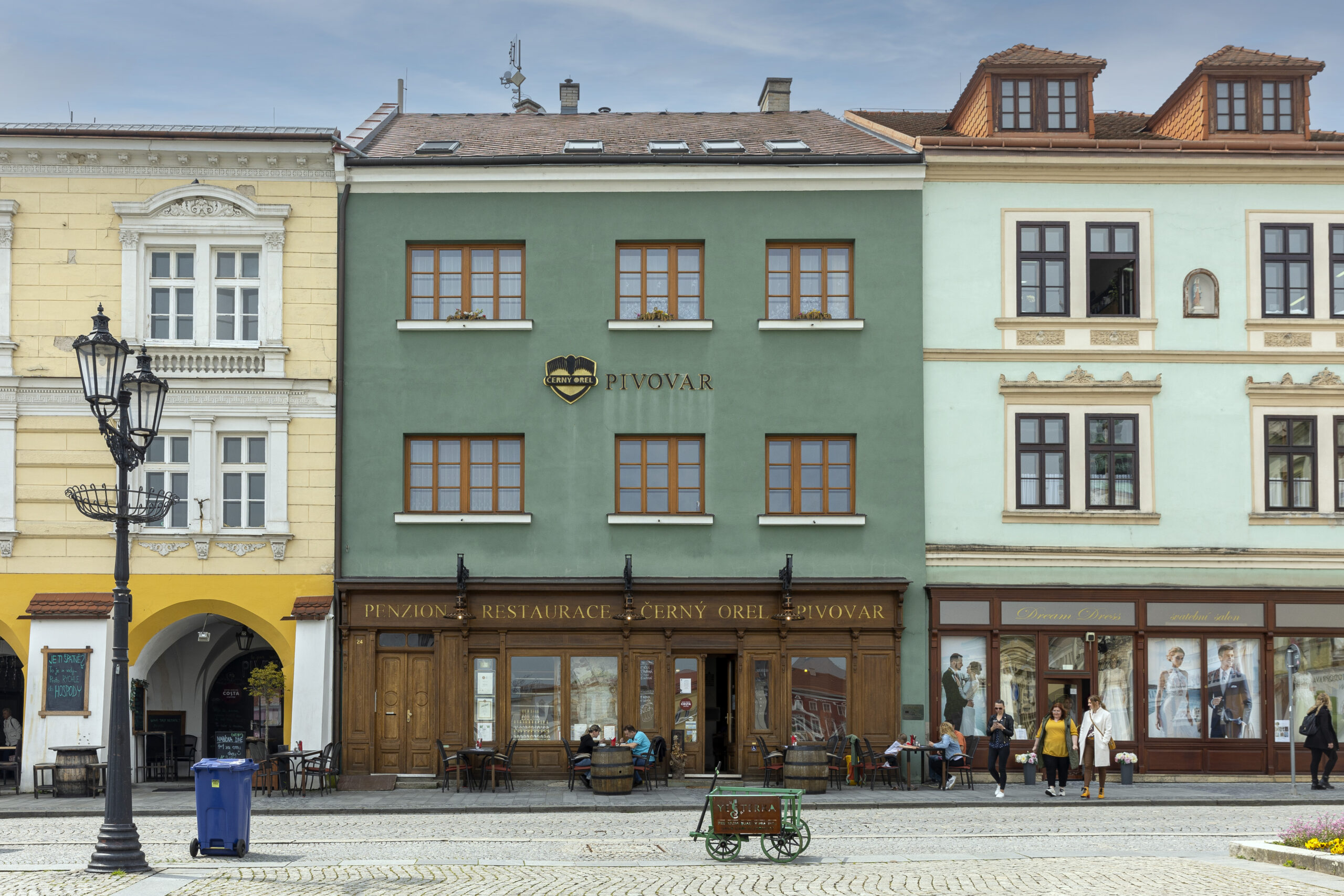
3 – Černý orel Brewery No. 24
One of the oldest and best preserved burgher buildings (the first brick building was built here after 1436) continues the tradition of taprooms and brewhouses on the square –a small private brewery operates here. The name of the brewery refers to the pharmacy U Černého orla (At the Black Eagle), which was located in the house in the 18th century.
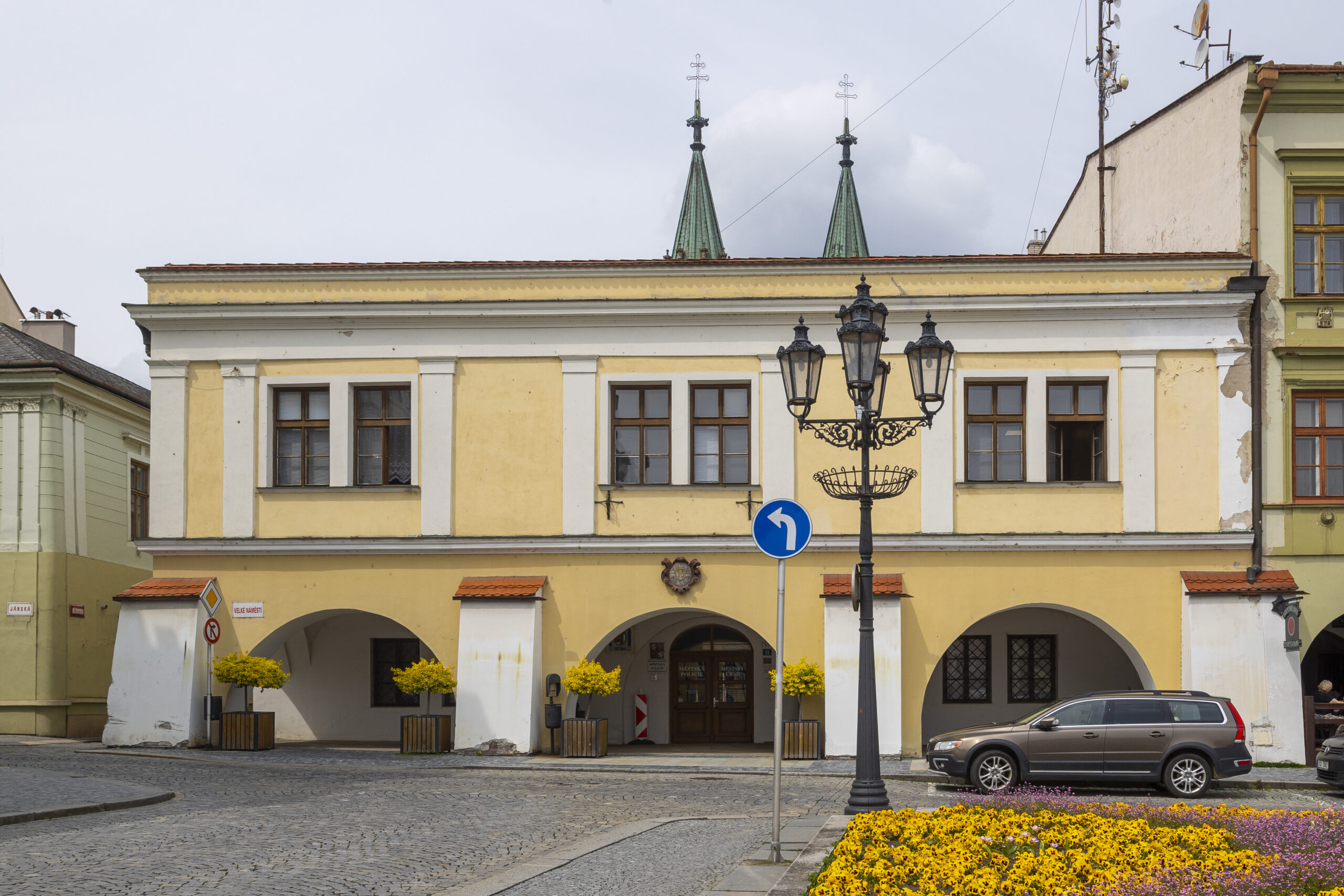
4 – Municipal House, No. 33
The one floor house on a wide allotment has belonged to the city since 1764. On the façade there is the coat of arms of the city. Part of the municipal office is located here and on the ground floor there is a police station.

5 – House at the Golden Sun, No. 34
The burgher house, originally from the 15th century, underwent Renaissance, Baroque and also Classicist adaptations. The main façade has a preserved appearance from the second half of the 19th century. In the house where we can find today the restaurant Vodní meloun (Watermelon), a forgotten famous director Robert Land was born, he is commemorated by a memorial plaque.

6 – Café Corso, No. 36
As well as the reconstruction of the neighbouring building No. 37, the Art Nouveau reconstruction of this house was taken care of by architect Felix Skibinský. He placed fairy-tale late Art Nouveau motifs on the façade. In the first half of the 20th century, a “cinematographic theater” was located in the house. Even today it is possible to have an unforgettable experiences from this place due to the mirror maze.
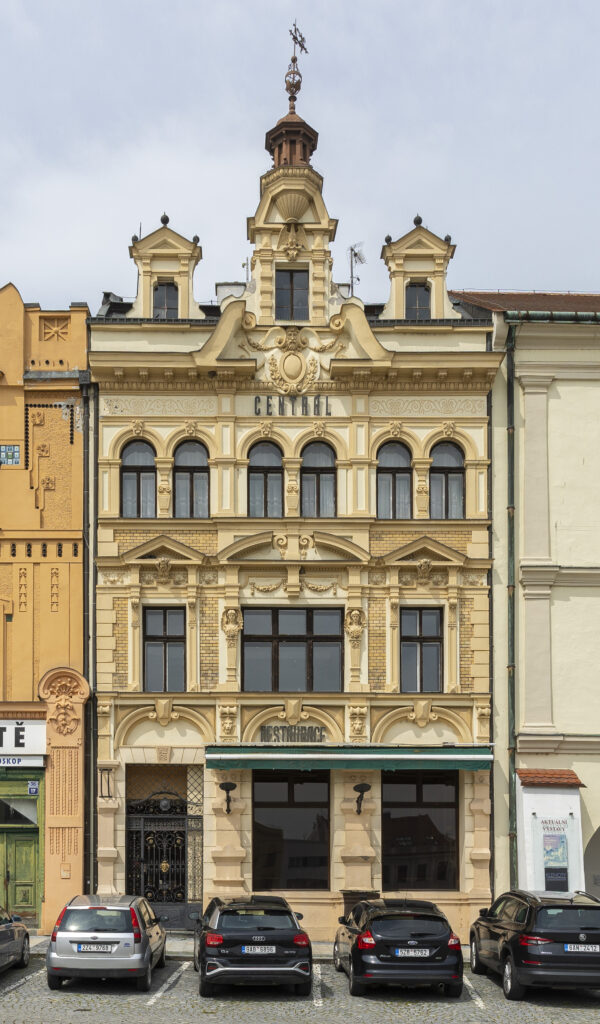
7 – Hotel Central, No. 37
Originally a taproom, the place have always functioned as a hotel or restaurant from the second half of the 19th century. An interesting element is the richly decorated metal grille, which was made in 1896 by a local blacksmith František Lukeš according to the design of architect Skibinský.
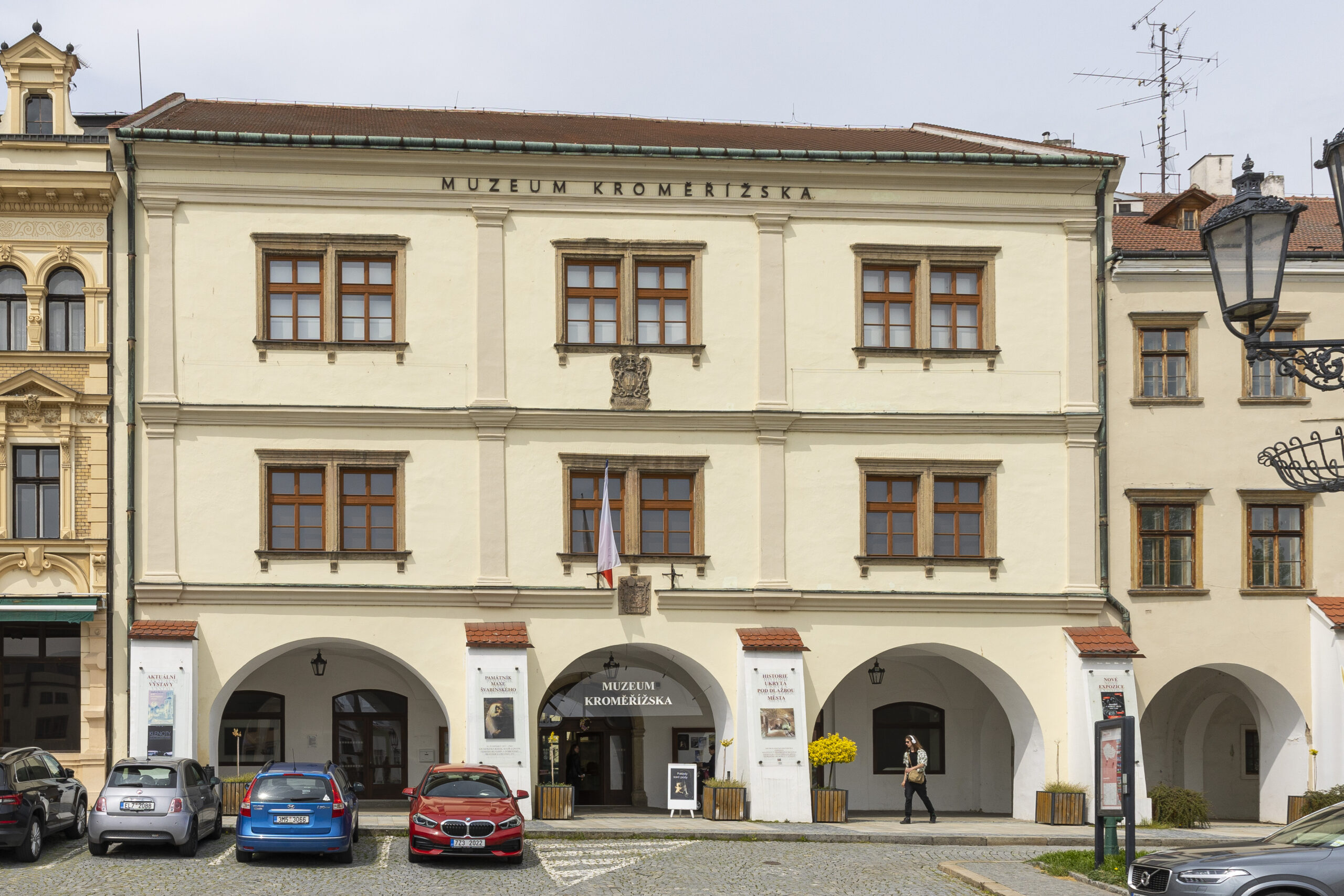
8 – Museum of the Kroměříž Region, No. 38
The house used to be called Kapitular or Lordship. It served the bishop and the Olomouc Chapter at the Cathedral of St. Wenceslas. The building was rebuilt several times by the bishops of Olomouc and after its destruction by the Swedes also by Bishop Karl of Lichtenstein-Castelcorno, who used it for housing. This is evidenced by the heraldic plaque on the façade at the level of the 1st floor. At present, the Museum of the Kroměříž Region is located here.
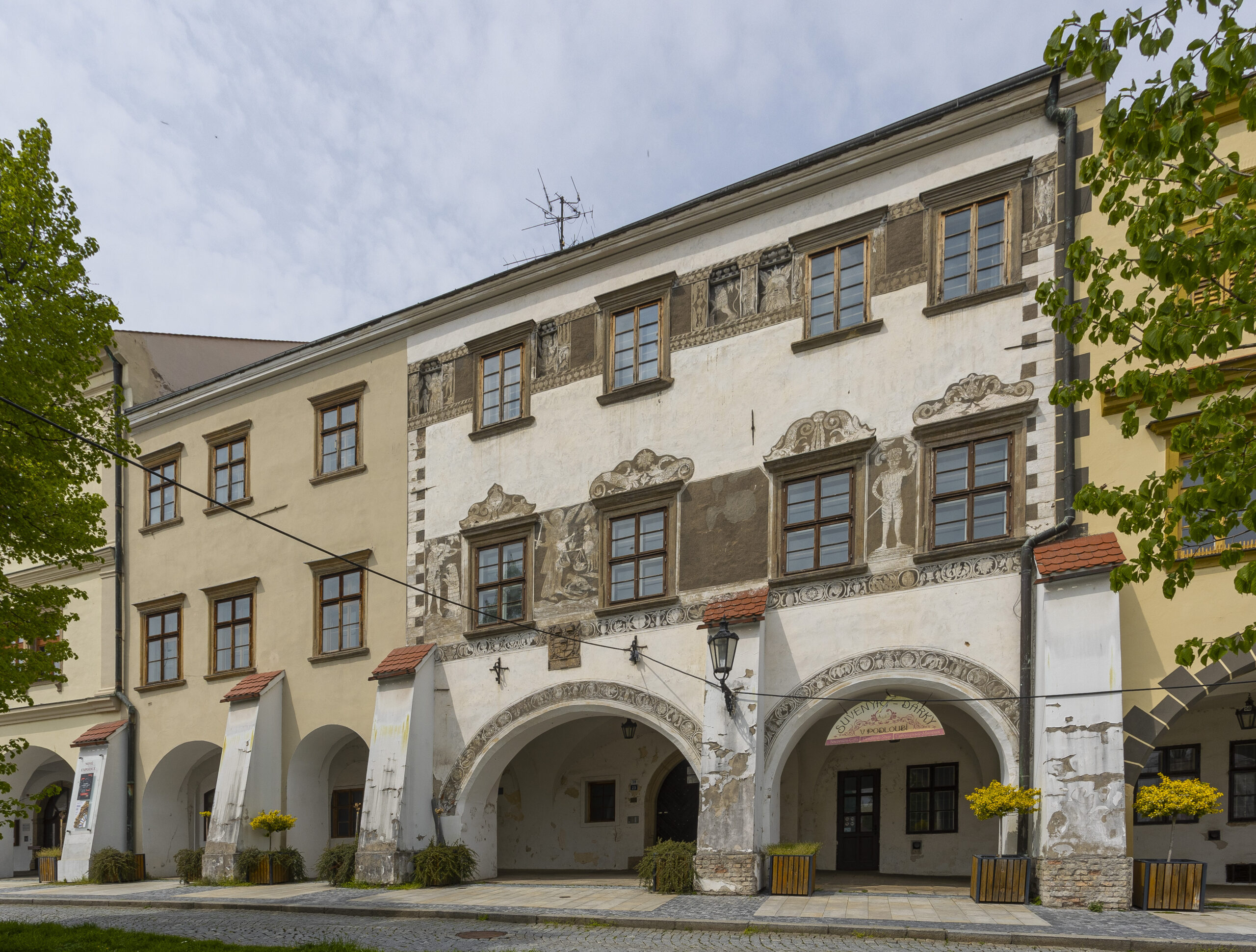
9 – Regency House, No. 39
The representative house was named after the regent of the bishop’s estates, Jan Mikuláš Reiter of Hornberg, who arranged for two buildings to be united in the middle of the 17th century. One of them displays sgraffito with the motif of the Last Judgement on the façade.

10 – Aristocratic House, No. 41
A townhouse with an unusual floor plan and a number of remarkable architectural details. The house was bought and modified for administrative purposes (there was a bishop’s accounting office) by Bishop Karl of Lichtenstein-Castelcorno. An interesting object is the portal with the bishop’s coat of arms around the side door and stone profiled jambs of all windows. Today the the place functions as a café.
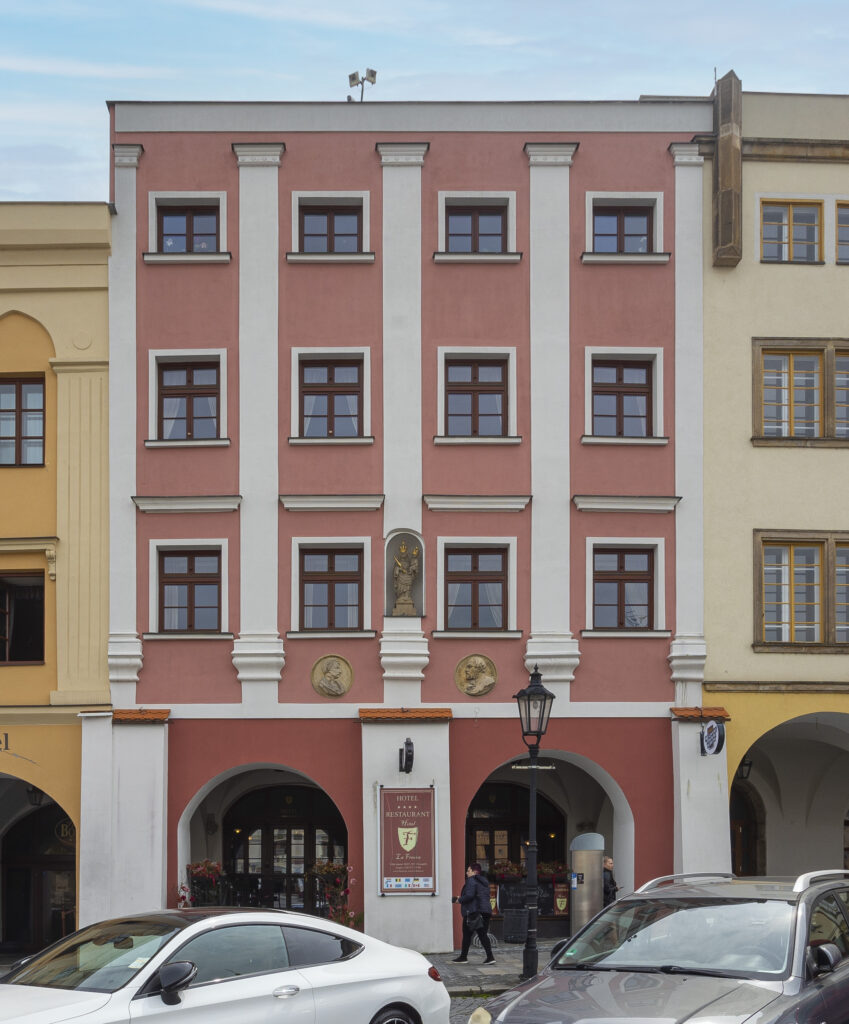
11 – Lontan House, No. 42
A highly valued house with an original medieval layout, Renaissance reconstruction and Baroque façade. It is named after its owner Jan Adam Lontan, a town notary and later burgomaster. It houses the Purkmistr Hotel and a café. The ground floor has vaulted ceilings and the stucco decoration of the vaults at the back of the café has been preserved.
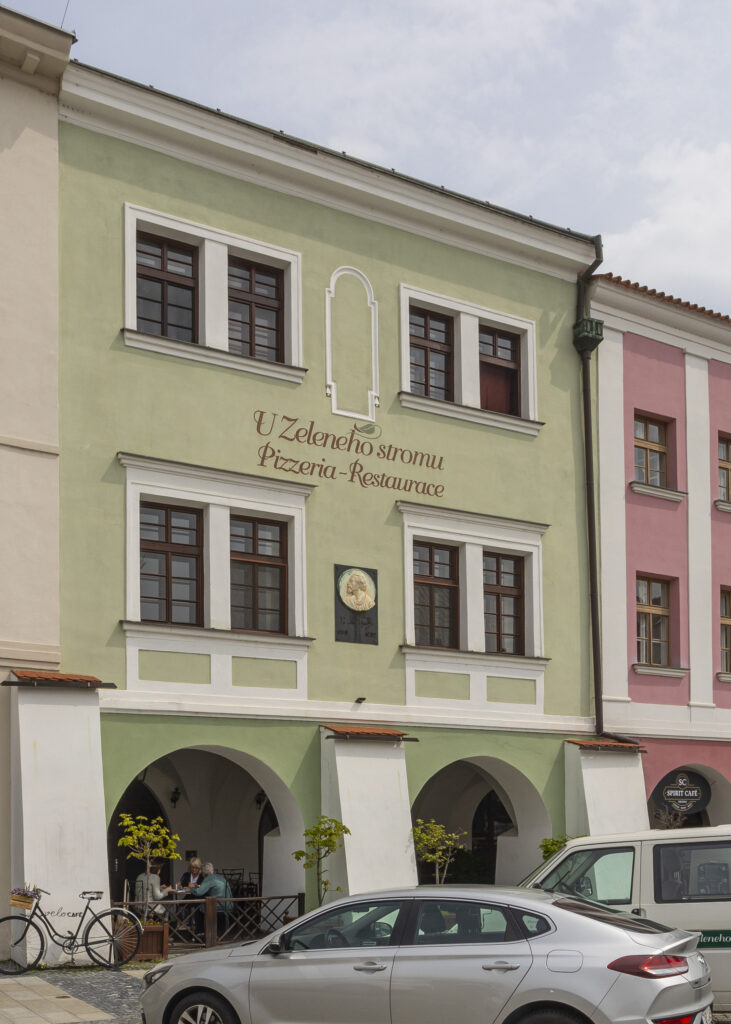
12 – House At the Green Tree, No. 47
The house was built around 1500 on a traditionally narrow plot. At the end of the 17th century it was owned by the engraver of the Kroměříž bishop’s mint, Kryštof Baltazar Hofman. It is particularly interesting because during the meeting of the assembly in 1848 Alexander von Bach, the Austrian Interior Minister, stayed here. His name is particularly associated with the suppression of liberal development in the country and the internment of K. H. Borovský to Brixen. A memorial plaque on the house commemorates another important guest – Miroslav Tyrš, who stayed here in 1865.
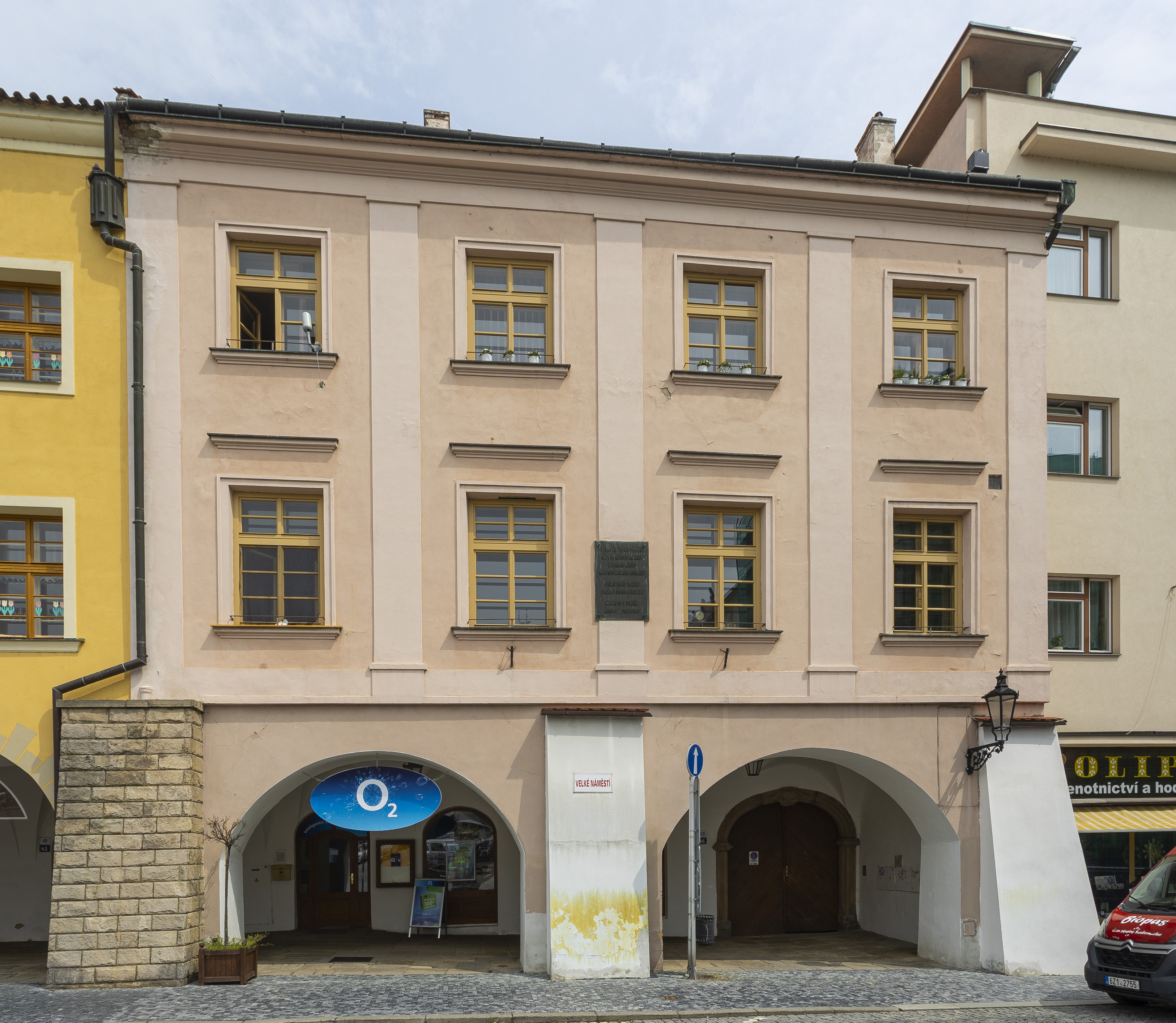
13 – House At the Golden Deer, No. 50
The extensive three-winged Baroque house was owned at the beginning of the 19th century by the prominent Moravian economist Anton von Kaschnitz, later it turned into the Vrbík’s Café. At the time of the Reichstag 1848/1849, the Slavic parliamentary club had its base here and František Ladislav Rieger and František Palacký spoke from the windows to people standing on the square.
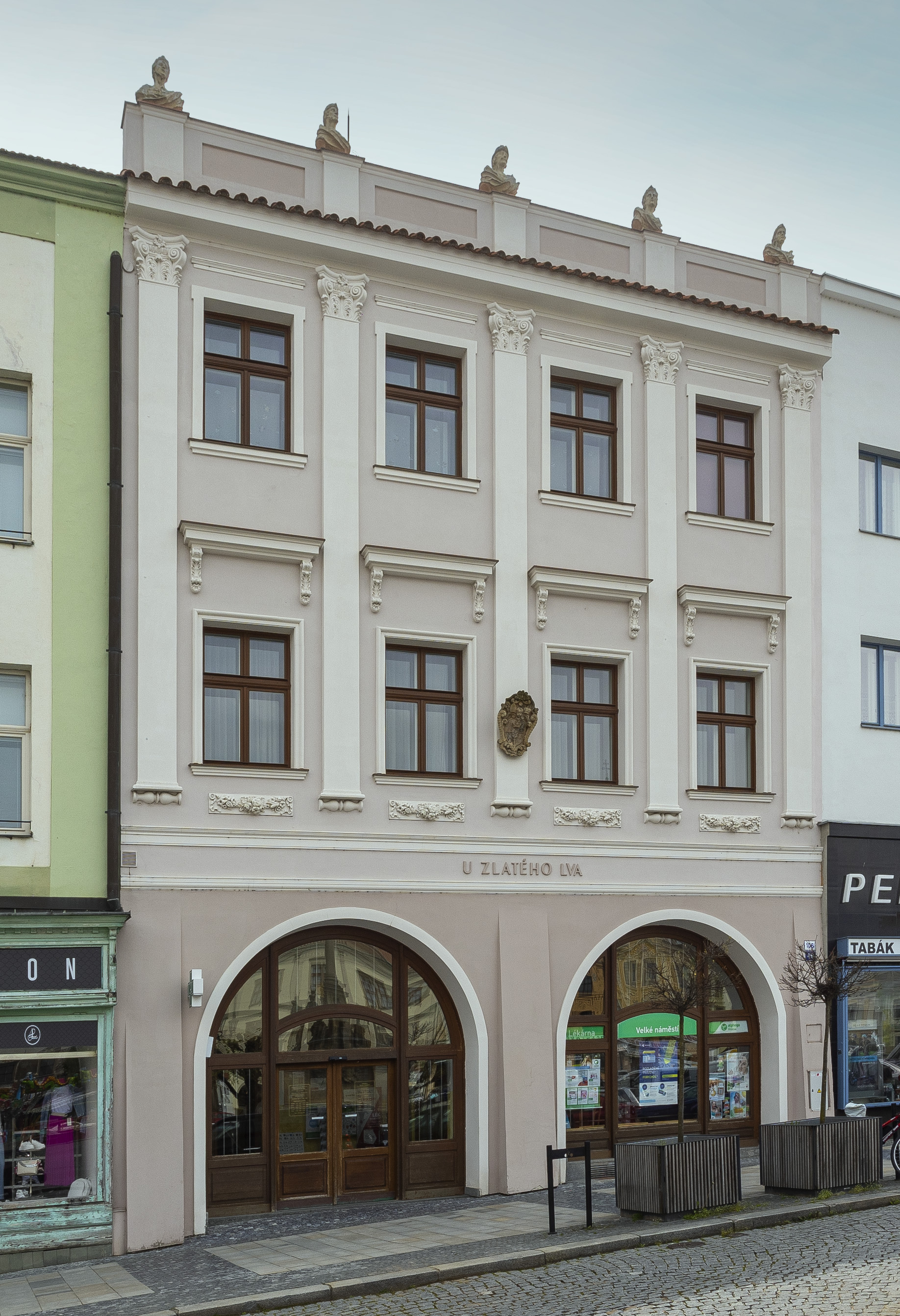
14 – House at the Golden Lion, No. 106
One of the most impressive burgher houses from the 16th century. After the reconstruction in the 1670s, it housed the main town pharmacy. The building is decorated on the upper attic with five busts of ancient emperors, which were created in the 18th century by the Kroměříž sculptor František Ondřej Hirnle. The pharmacy (and doctors’ offices) are still located there.

15 – Burgher House, No. 109
This originally Renaissance house is decorated in the niche on the façade with a statue of the Virgin Mary Křtinská and medallions of the participants of the Constituent Assembly in 1848 Karel Havlíček Borovský and František Augustin Brauner. Currently the house serves as a hotel.

16 – Hotel Haná, No. 110
Jan Simon, the owner of the famous smoked meats factory, rebuilt this 16th century house into an inn in the 19th century and later into a hotel known as Haná. Reconstructions in the 1950s and unfinished building adjustments from 2000-2001 transformed it beyond recognition. At present, unfortunately, the building is empty and dilapidated.

17 – House of P. J. Vejvanovský, No. 112
The burgher house of early Renaissance origin was owned and rebuilt between the years 1666–1693 by Pavel Josef Vejvanovský, bandmaster and composer of Bishop Karl of Liechtenstein-Castelcorno and also then director of the choir of the Church of St. Maurice.

18 – Marian column with a statue of the Virgin Mary on the Great Square
It was built in 1681 to express gratitude for overcoming the plague epidemic. The statues standing at the foot of the column represent St. Wenceslas, St. Maurice, St. Roch and St. Florian. Since 1978, the column has been a cultural monument, in 2020 and 2021 it underwent the last reconstruction, including the gilding of the statue of the Virgin Mary on the top.
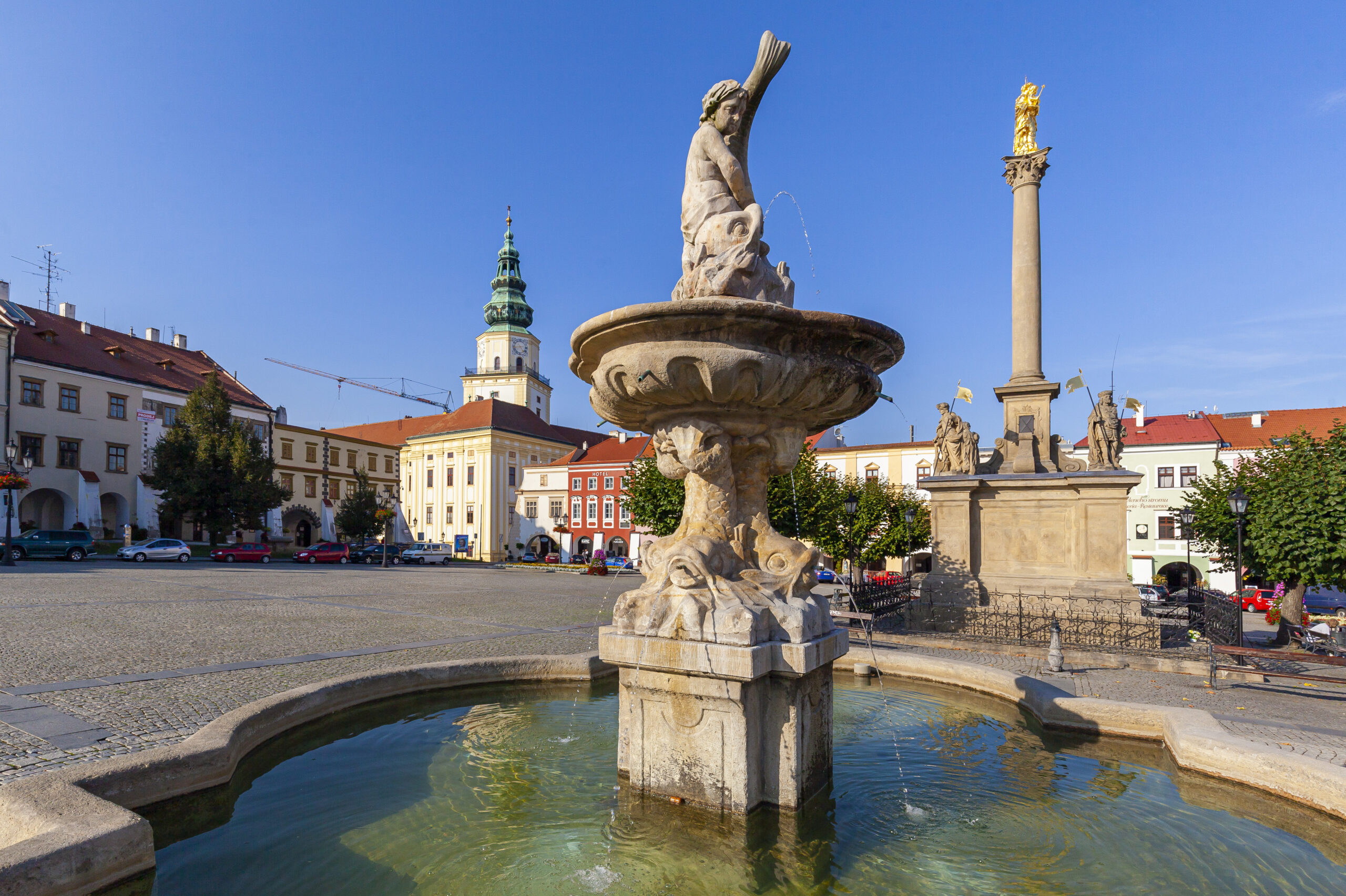
19 – Fountain with Putto on a dolphin
The original installation of the Baroque fountain was probably created during the reconstructions of the town after the Thirty Years’ War. The appearance of the sculpture with four dolphins (gargoyles) is inspired by the Fontana del Tritone in Rome. The boy on the dolphin symbolizes the “friendly relationship” and portrays Bishop Lichtenstein’s warm feelings towards the city. Its view is directed at a nearby plague column.
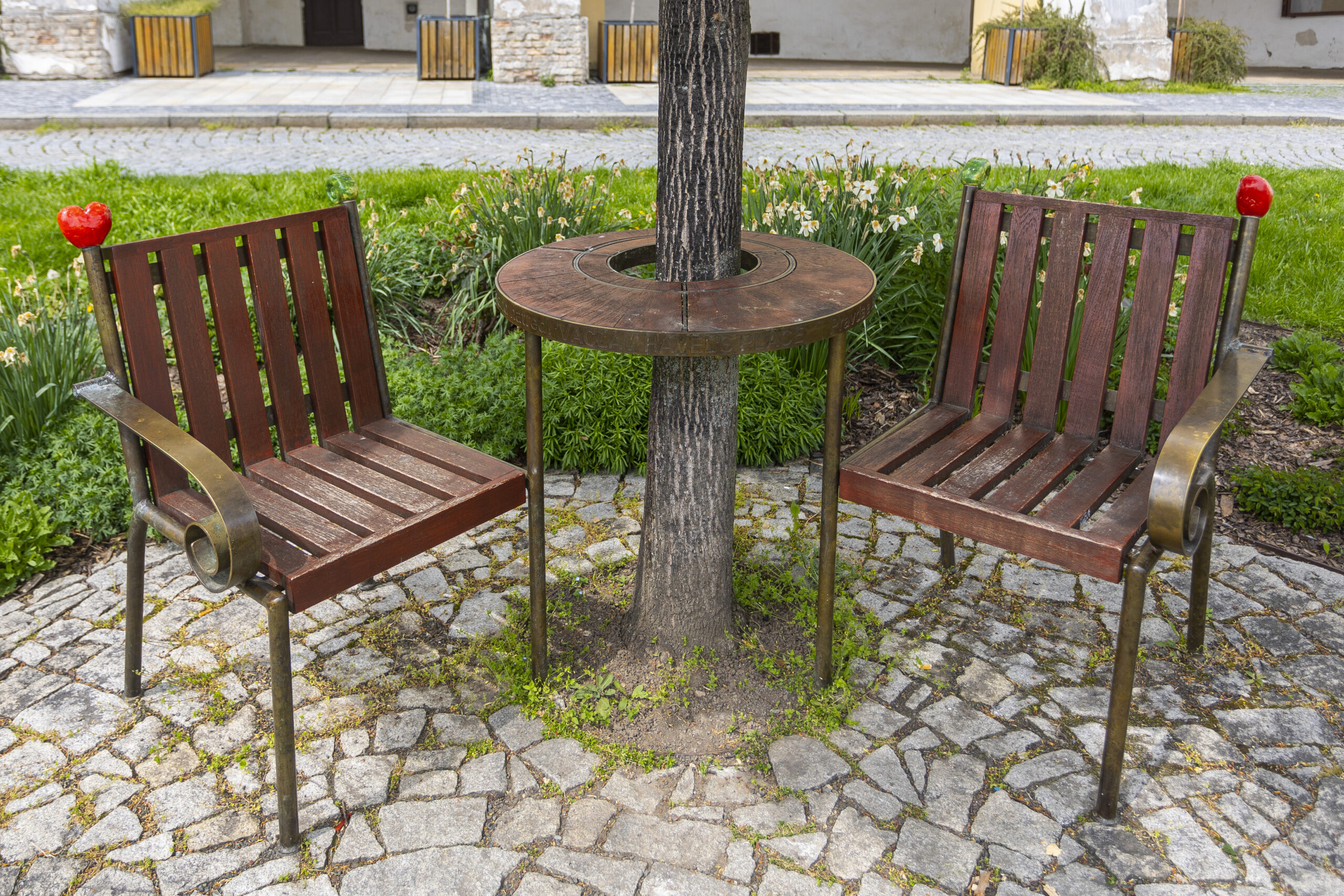
20 – Václav Havel’s bench
A pair of armchairs with a round table, through which the trunk of a linden tree grows, is located in the northern part of the Great Square in front of the Regency House No. 39. The author of the symbol of mutual dialogue and understanding is the architect and designer Bořek Šípek. The bench has been in Kroměříž since 2016 and it was the first Václav Havel bench in the region of Moravia.
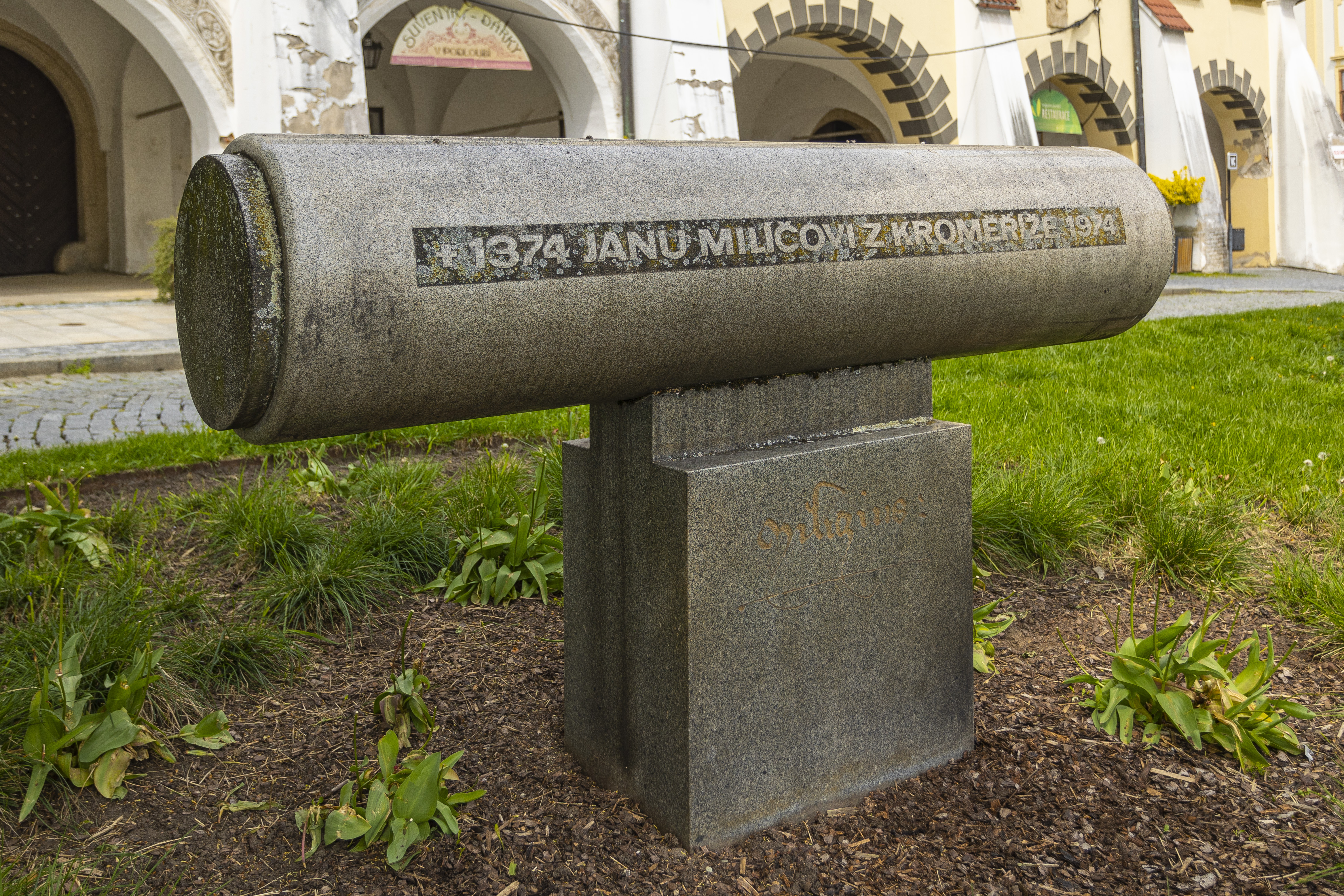
21 – Monument of Jan Milíč of Kroměříž
The monument of the preacher and church reformer of the pre-Hussite period, Jan Milíč of Kroměříž, stands in a grassy area in front of the Museum of the Kroměříž Region No. 38. The architect is Bedřich Hanák and it is made of Silesian granite. Jan Milíč worked in Kroměříž for some time, he was a church dignitary and imperial official, even a collaborator of Charles IV and later ironically his opponent.


